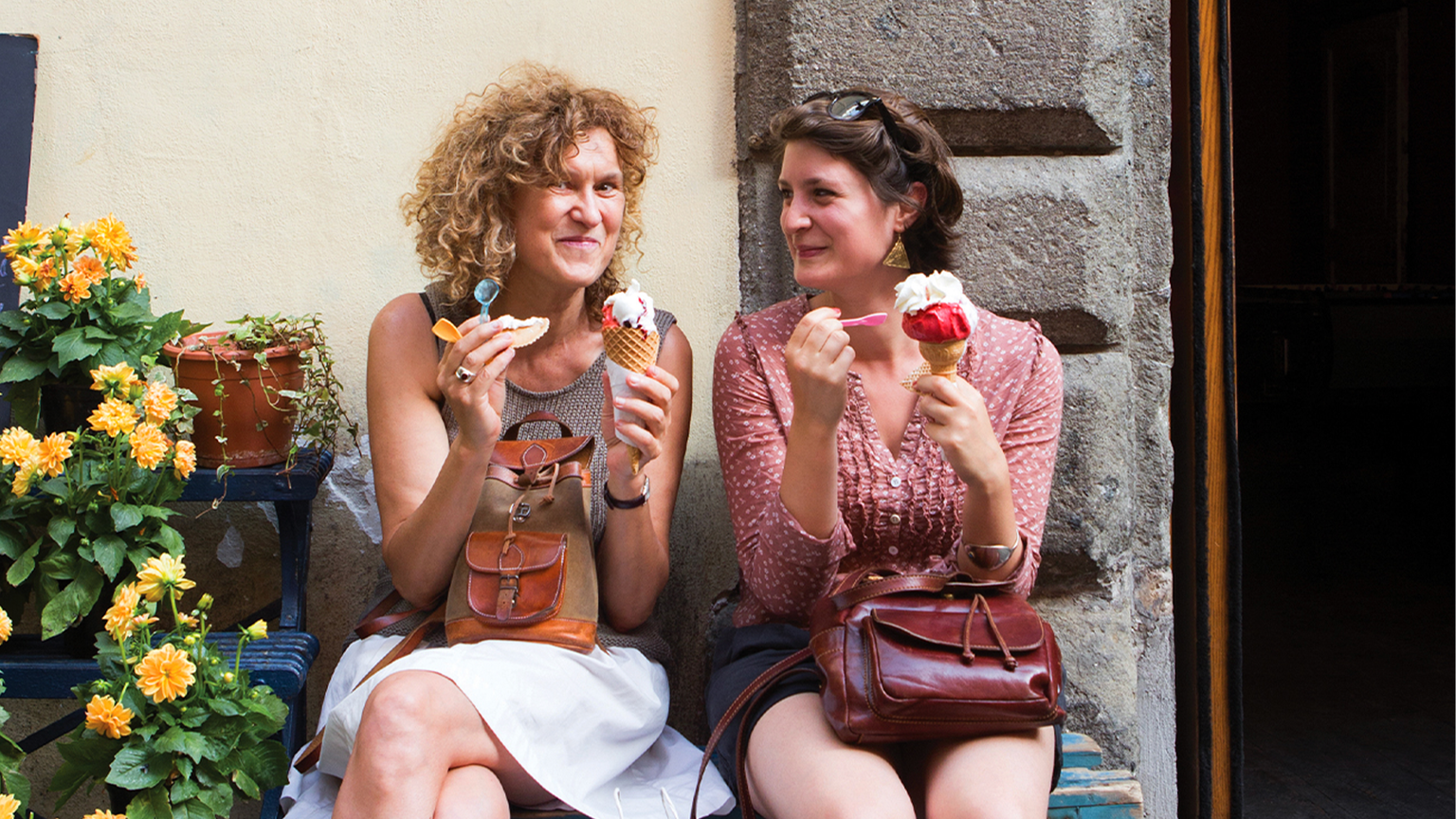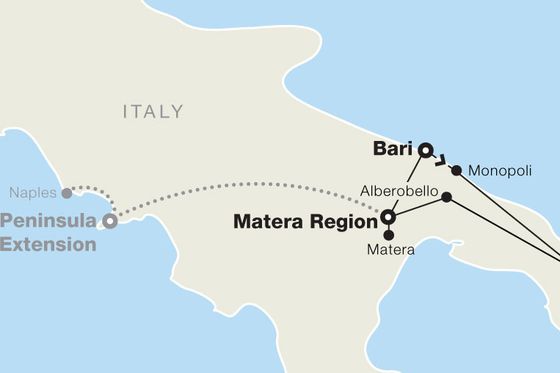The scoop on ordering gelato in Italian (and why it’s not just ice cream)
Gelato—one of Italy’s most beloved treats that’s often referred to as Italian ice cream—is a highlight of any trip to Italy. Here’s our guide to ordering gelato in Italian.
Gelato means “frozen” in Italian, but don’t confuse it with ice cream. Denser, silkier, and packed with flavor, authentic Italian gelato is in a league of its own. And after a warm, sunny day on a tour of Florence exploring museums, Renaissance architecture, and leather markets, there’s no better way to cool off than with a scoop (or two) of the real thing.
A tasty grab-and-go treat—day or night, summer or winter, for breakfast or dinner—gelato is a must-do in Florence, Rome, Venice, and everywhere else your trip to Italy takes you. The secret to making it even better? Ordering it in Italian. Not only will you feel accomplished, but you’ll impress the locals, too. Read on for our guide to ordering gelato in Italian.
What is gelato? Is it Italian ice cream?
Before we start with the language lesson, let’s touch on a critical culinary distinction: For many, it’s easy to simplify gelato as ice cream in Italian, but in truth, gelato is tangibly different from ice cream. Yes, both are cold, creamy, sweet, and delicious. But gelato is made of more milk than cream (ice cream is the reverse), denser in texture, and generally more flavorful. So, when on our Italy tours, do take care to avoid saying that gelato is just ice cream in Italian. (After all, you don’t want to irk any locals who hold their country’s signature sweet treat in high esteem.)

How to order gelato in Italian: basic phrases and vocabulary
As far as basic phrases and vocabulary go, the ones you’ll use to order your gelato in Italian are easy to learn and remember.
Let’s start with words related to the size of the gelato you want to order:
- Piccolo (PEE-koh-loh) for small
- Medio (MEH-dee-oh) for medium
- Grande (GRAHN-day) for Large
Would you prefer your gelato served in a cup or cone?
- Cono (KOH-noh) is cone in Italian
- Coppetta (koh-PET-tah) is cup in Italian
Don’t forget to be polite about it.
- Per favore (pehr fah-VOH-reh) for please
- Grazie (GRAHT-see-eh) for thank you
Easy, right? While travelers often opt for cones for the photo-worthy aesthetic, many Italians prefer cups so they can savor the flavor without worrying about melting woes. Also, don’t expect towering scoops. Portions are smaller, opting for quality over quantity, and you’re encouraged to choose at least two flavors—even if you order a small.
Ordering gelato in Italian can be as short as saying “un gelato, per favore” or “one gelato, please.” But if you really want to impress everyone around you, here’s how to flesh out that sentence:
“Buongiorno, vorrei un gelato piccolo in cono, per favore.” In English, that’s “Hello, I would like a small gelato in a cone, please.”
From there, to order your gelato in Italian, you just need to fill in the blanks.

How do you say gelato flavors in Italian?
Now that you have most of the basics down, the next part might be the best part: learning the different flavors. Depending on which regions you visit in Italy, some flavors are more popular than others. Italian cuisine is heavily shaped by local traditions and ingredients so of course gelato is, too. This means you may want to try hazelnut gelato on a Piedmont tour, or almond or lemon gelato when you go to Sicily.
Picking your flavors (il gusto) will be a very personal choice, so here’s a rundown of some of the most common gelato flavors you’ll find all over Italy. But don’t just memorize your favorites, because if you find yourself gelato-hopping in Florence or Rome, you should try as many flavors as possible, and you’ll know exactly how to order gelato in Italian.
- Amarena: Sour cherry
- Caffe: Coffee
- Cannella: Cinnamon
- Cioccolata: Chocolate
- Cioccolato fondente: Dark chocolate
- Fior di latte: Directly translated, this means “flower of milk.” This flavor is most similar to what we’d call sweet cream.
- Fragola: Strawberry
- Nocciola: Hazelnut
- Gianduia: Hazelnut and chocolate
- Pistacchio: Pistachio
- Stracciatella: Chocolate chip
- Vaniglia: Vanilla
- Mandorla: Almond
- Menta: Mint
- Cocco: Coconut
- Limone: Lemon
- Biscotti: Cookies or biscuits
- Zabaione: Custard

Tips for enjoying gelato in Italy
Now that you know how to order gelato in Italian (including how to say please, thank you, cup, and cone in Italian), we have a few additional tips and tricks for how to best enjoy your gelato on our Italy tours.
Avoid gelato in bright, unnatural colors
As fun as it might be to tuck into a cone of neon green pistachio gelato, unnaturally bright, bold colors should be avoided. Gelato should resemble the natural colors of the ingredient or ingredients that give it its flavor. Typically, pistachio should be a light shade of brown, not vibrant green. Bright blues, pinks, and greens could mean that the gelato shop is using artificial food coloring.
Gelato should be packed flat in its serving container
This is the best way to keep gelato as cold as possible for as long as possible. Gelato that’s piled high in the freezer case is usually for show and has likely been fluffed up, meaning the gelato itself is no longer as dense as it should be. In this case, you’re left with air.
Go seasonal
Make sure you order a flavor that’s in season. In fact, if you see a shop selling an out-of-season flavor, you should head to a different gelateria altogether. Here are some of our favorite seasonal gelato flavors.
- Spring: Fragola (strawberry). It’s at its peak in late spring.
- Summer: Pesca (peach), melone (cantaloupe), and fico (fig). These fruity flavors are the perfect summer pick-me-up.
- Fall: Castagna (chestnut) and mela e cannella (apple with cinnamon). There’s no better way to celebrate the autumn harvest.
- Winter: Arancia rossa (blood orange) and pera (pear). These fruits shine in winter months.

Where to find the best gelato in Italy
Regardless of where our Italy tours take you, delicious gelato will be just around the corner. And now that you know how to order gelato in Italian, it only makes sense to visit as many of the country’s best gelaterias as possible. And remember: You can always ask your Tour Director for suggestions, too. They’re experts!
Florence
According to Tour Director Sabra, Vivoli is a Florentine classic beloved for its timeless and historic atmosphere as well as its Millefoglie gelato. She also loves the elegance you’ll find at De Medici, which serves not only fabulous gelato, but also pastries and fruit stuffed with sorbet.
Rome
Near Piazza Navona, at Gelateria del Teatro, you can see the gelato being made, so you know it’s good. We love the variety of flavors here, which include the basics but also more unexpected options like chocolate truffle and ginger. In Trastevere, check out Otaleg (yes, that’s gelato spelled backwards) for a fantastic selection of fruity, dairy-free sorbet. (But they serve regular gelato flavors, too.)
Venice
One of the city’s most popular spots, teeny-tiny Gelateria Gallonetto will likely have a line when you arrive. But its affordable and flavorful gelati (from stracciatella, with its shards of dark chocolate, to amarena, with its bits of cherries and swirls of cherry syrup, to tiramisu, with its punch of espresso and tang of mascarpone) will be worth the wait.
Bologna
Cremeria Santo Stefano is a bit out of the center. But it’s a trusted favorite that serves classic flavors, unexpected twists, and rotating specials—all of which keep locals coming back for more.
Milan
Steps away from the Duomo, Ciacco gets very creative with its recipes, so expect to find more unusual flavor combinations—including ones with alcohol, like salted butter with bourbon or chocolate with rum.














































































)










)







